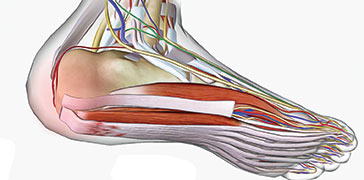US Pharm. 2024;49(1):15-16.

Inflammation of the Plantar Fascia
Plantar fasciitis is a very common cause of heel pain and results from inflammation of the plantar fascia, a thick band of fibrous tissue that runs from the heel of the foot to the ball of the foot and toes. This is usually stretchy like a rubber band, but with overuse or over time, continued pressure can damage or tear the tissue, causing inflammation. The body’s ability to repair itself cannot keep up, and the inflammation causes the fascia to lose its elasticity and become irritated. Plantar fasciitis occurs often in those who run, jump, or stand for long periods. It can make it difficult to walk or do routine activities. Rest and several months of home therapies usually help alleviate plantar fasciitis, but if left untreated, it can cause chronic pain in the foot and other joints, too.
A Common Cause of Heel Pain
One in 10 people will experience plantar fasciitis. Individuals usually experience pain at the bottom of their foot near the heel and the sole. People often say that their pain occurs with the first steps of getting out of bed or after a long period of rest. Walking barefoot or in shoes with minimal support worsens plantar fasciitis pain. Activity may temporarily relieve the pain, but it could worsen again with prolonged activity or once the activity stops. Diagnosis is made by a doctor through a physical exam and information gathered from the patient’s medical history. No imaging is usually needed. On occasion, an x-ray or MRI may be used to make sure there are no other reasons for the pain, such as fractures.
Risk Factors
People with a lifestyle that involves repetitive impact to the heel are most likely to develop plantar fasciitis. It is most frequent in those who run but can happen in people who stand or walk for long hours, especially on hard surfaces; participate in high-impact activities that put stress on the feet or heels, such as excessive training, running, marching, and dancing; are obese; have high arches or flat feet; are aged between 40 and 60 years; or have limited ankle flexibility or tight calf muscles.
Treatment
There are no specific treatments for plantar fasciitis, but there are ways to manage the pain. Symptoms may take longer to go away if they have been around for a long period or if they are severe.
Decreasing activities that worsen the pain or put stress on the feet can help with plantar fasciitis. However, a complete lack of physical activity is not recommended because it can cause stiffening and pain to return. Icing the feet for 20 minutes four times a day may also relieve pain, but make sure to place a thin towel between the ice and the skin. It may also help to ice and massage the feet before exercise. Other things that could be tried include stretching exercises, such as the calf–plantar fascia stretch, foot/ankle circles, toe curls, and towel curls. Make sure to go slowly and carefully when starting these exercises. Strengthening exercises to stabilize the ankle and massage could provide relief, too. Using athletic tape to support the muscles and ligaments may be helpful as well.
A doctor may even suggest wearing a boot to take some stress off the foot. Switching to shoes with more arch support, adding heel cups or gel-padded orthotics in the shoes to cushion the heel, wearing shoes with rigid soles, or wearing night splints may provide relief. Walking barefoot or wearing slippers, flip-flops, poorly fitted shoes, or worn-out shoes should be avoided because this may cause the symptoms to return. Nonsteroidal anti-inflammatory drugs can be used to help with pain and inflammation, but it is important to talk to the doctor before taking them to make sure there are no issues with any medical conditions and other medications.
If the Condition Persists
Patients who do not find relief with these simple treatments within several months may need a steroid injection; however, its pain-relieving effects may not last long, and it can be painful, with a small risk of infection. The doctor may also suggest a cast to keep the foot from moving. Ultrasonic tissue repair or extracorporeal shockwave therapy can also be tried, although these may not be useful. If all these treatments do not work, the last resort is to do surgery to relieve the tension in the plantar fascia.
The content contained in this article is for informational purposes only. The content is not intended to be a substitute for professional advice. Reliance on any information provided in this article is solely at your own risk.
To comment on this article, contact rdavidson@uspharmacist.com.





